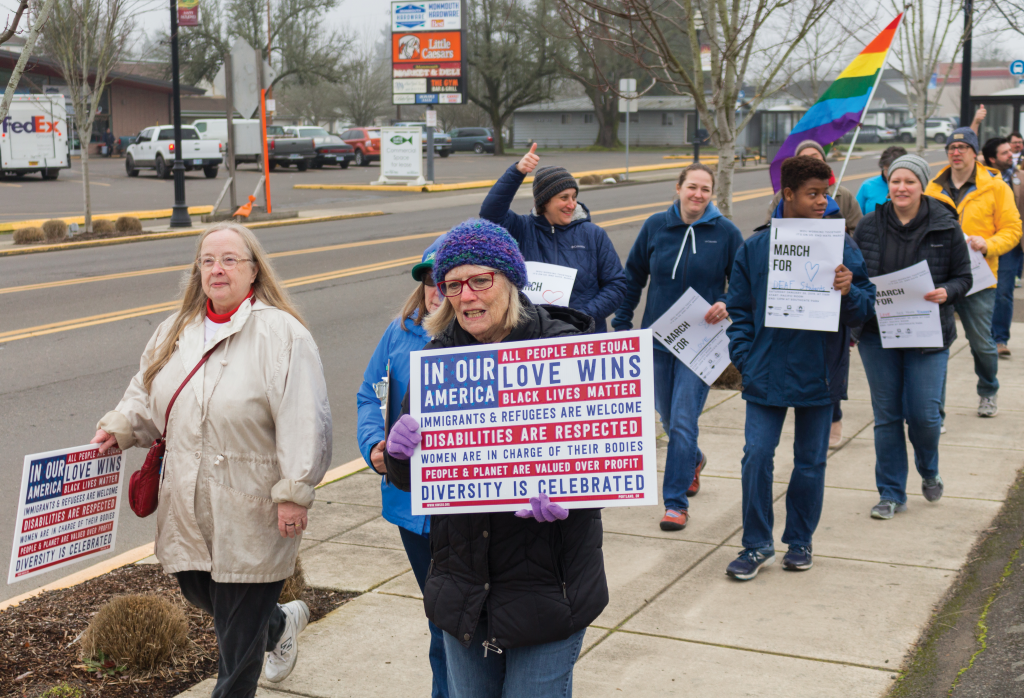
Bailey Thompson | News Editor
Back in November, an instance of hate speech graffiti was found in the Monmouth community which consisted of swastikas and the words “Proud Boys” and “MAGA.”
The following day, organizations at Western began releasing statements that renounced the behavior and promised action.
“We had two students — Logan Jackson and ZZ Braatz — suggested that we do a march in response to this. So, we started planning late November or early December, and it was a three-step process,” said Kelsey Murray, Ackerman Hall Resident Director and one of the march’s organizers. “The first part was that we put up ‘End Hate’ signs that link to the bias-motivated incident response form, we did tabling for a week where we advertised the campaign as well as the march and then the third part was the march.”
Leading up to the march, a committee was formed, and they tabled to spread awareness in the community for the upcoming event.
On the morning of the march, Jan. 26, members of the Monmouth and Western community came together to listen to speakers as they made signs.
 “The graffiti placed here is not only a manifestation of a larger act, but an escalation of hate that must be conquered,” said Monmouth City Councilor Christopher Lopez. “To oppose bad things in this world, we must not only feel the good and embrace it, but act upon it. This togetherness, love, caring, openness, kindness and understanding only has power when it is paired with action.”
“The graffiti placed here is not only a manifestation of a larger act, but an escalation of hate that must be conquered,” said Monmouth City Councilor Christopher Lopez. “To oppose bad things in this world, we must not only feel the good and embrace it, but act upon it. This togetherness, love, caring, openness, kindness and understanding only has power when it is paired with action.”
Building off of this idea, Linda Williams read sentiments in a letter from Representative Paul Evans about how vital it is for people to combat hate that they see around them.
“Something has happened in our nation, state and community. Somehow, we have drifted into treacherous waters,” wrote Evans. “We have tolerated a downward spiral in our basic civility and…respect. We have allowed the fragile fabric of our union to unravel.”
Moving forward, though, Evans also offered a message of hope.
“Hate has no place in America, in Oregon or in our community…we are one — together against bigotry, intolerance and racism. Together we can defeat hatred through compassion and empathy,” said Evans.
The final speaker before the march was Nathan Soltz, ASWOU Senate President, who shared his perspective on the act of hate.
“I thought it was really difficult to put into words what my visceral reaction was because, as a Jew, when these events happen I feel compelled to remember the hatred that the generations before me faced,” said Soltz. And while…gross ignorance isn’t really as noticeable today, the bigotry persists. And it can be seen really obviously in the graffiti, but it can also be a lot more subtle.”
Soltz then explain how this bigotry can take a number of forms.
“It can take the form of someone crossing the street when they see a person of color walking towards them on the sidewalk,” or “an unqualified man telling a qualified woman how to do her job … someone thinking that someone with a disability is somehow less important … not recognizing that someone’s gender is what they say it is, not what you think it is,” said Soltz.
Rounding out his remarks, Soltz shared how disappointed he was that the Monmouth Police didn’t acknowledge this incident of graffiti to be “threatening.”
“I hate that we have to actually have a march against hate — that we have to stand up and say that being a Nazi is bad, because apparently today that’s no longer a given,” said Soltz.
At this point, the marchers practiced their chants and were ready to head out. The whole group marched through town and all the way to the site of the graffiti near Southgate Park, where city officials had agreed to let participants write countering messages in chalk on the sidewalk.
“I’m sure that the incident of vandalism really made them feel isolated, and I hope that the community feels a little less alone,” said Murray at the end of the march. “And I hope that the people who attended the march feel more empowered to be the active bystander and to stand up to hate that they witness. Especially in our current political climate, I hope that they feel that they can make a difference.”
Contact the author at howlnews@wou.edu
Photo courtesy of Ashlynn Norton

